Solar eclipse of March 20, 2015
A total solar eclipse occurred on March 20, 2015. A solar eclipse occurs when the Moon passes between Earth and the Sun, thereby totally or partly obscuring the image of the Sun for a viewer on Earth. A total solar eclipse occurs when the Moon's apparent diameter is larger than the Sun's, blocking all direct sunlight, turning day into darkness. Totality occurs in a narrow path across Earth's surface, with a partial solar eclipse visible over a surrounding region thousands of kilometres wide. This total solar eclipse is notable in that the path of totality passed over the North Pole. Totality was visible in the Faroe Islands and Svalbard.
| Solar eclipse of March 20, 2015 | |
|---|---|
._(32844461616).jpg) From Longyearbyen, Svalbard | |
 Map | |
| Type of eclipse | |
| Nature | Total |
| Gamma | 0.9454 |
| Magnitude | 1.0445 |
| Maximum eclipse | |
| Duration | 167 sec (2 m 47 s) |
| Coordinates | 64.4°N 6.6°W |
| Max. width of band | 463 km (288 mi) |
| Times (UTC) | |
| Greatest eclipse | 9:46:47 |
| References | |
| Saros | 120 (61 of 71) |
| Catalog # (SE5000) | 9541 |
It had a magnitude of 1.045. The longest duration of totality was 2 minutes and 47 seconds off the coast of the Faroe Islands. It was the last total solar eclipse visible in Europe until the eclipse of August 12, 2026.[1]
The track of totality passed across the North Atlantic and into the Arctic Ocean.
Event
The solar eclipse began at 08:30GMT in North West Europe and moved towards the northeast but still in northern Europe. It was most visible from the North Atlantic and Arctic Oceans, Greenland, Iceland, Ireland, the United Kingdom, Faroe Islands, northern Norway and Murmansk Oblast. The shadow began its pass off the south coast of Greenland. It then moved to the northeast, passing between Iceland and the United Kingdom before moving over the Faroe Islands and the northernmost islands of Norway. The shadow of the eclipse was visible in varying degrees all over Europe.[2] For example, London experienced an 86.8% partial solar eclipse while points north of the Faroe Islands in the Norwegian Sea saw a complete solar eclipse.[3] Three chartered airliners flew above the clouds, giving passengers a slightly prolonged view.[4]
The eclipse was observed at radio frequencies at the Metsähovi Radio Observatory, Finland, where a partial eclipse was seen.[5] The eclipse was also observed by meteorological satellite Meteosat-10.[6][7]
Impact
The European Union has a solar power output of about 90 gigawatts and production could have been temporarily decreased by up to 34 GW of that dependent on the clarity of the sky. In actuality the dip was less than expected, with a 13 GW drop in Germany happening due to overcast skies.[8][9] This was the first time that an eclipse had a significant impact on the power system, and the electricity sector took measures to mitigate the impact. The power gradient (change in power) may be −400 MW/minute and +700 MW/minute. Places in Netherlands, Belgium and Denmark may be 85.2% obscured.[10][11] Temperature may decrease by 3 °C, and wind power may decrease as winds are reduced by 0.7 m/s.[12]
Coincidence of events
In addition to the eclipse, 20 March 2015 was also the day of the March equinox (also known as the spring or vernal equinox in the Northern Hemisphere). In addition, six supermoons were expected for 2015. The supermoon on 20 March 2015 was the third of the year; however, it was a new moon (near side facing away from the sun), and only its shadow was visible.[13]
At greatest eclipse, the Sun was at its zenith less than 24 kilometers south of the Equator. Greatest eclipse occurred at 09:45:39 UTC of Friday, March 20, 2015 while March Equinox occurred at 22:45:09 UTC, just under 13 hours after the greatest eclipse (Greatest eclipse occurred in winter, 13 hours before spring).
Religious Significance
Proponents of the Blood Moon Prophecy, such as Bob O'Dell[14] also pointed out that 20 March 2015 was also a significant day on the Jewish and Biblical calendar. That evening was the onset of the Hebrew month of Nisan, the first month in the Biblical calendar year. Furthermore, the path of the total eclipse over the North Pole[15] was a highly symbolic location infusing the day with both great natural significance and profound religious meaning according to O'Dell. Due to the significance of the eclipse, a global prayer event in Jerusalem was organized that day.[16]
Eclipse visibility
The event was visible as a partial eclipse all across Europe including: Norway, Sweden, Denmark, the United Kingdom,[17] Ireland,[18] Portugal, France,[19] Germany,[20] Poland,[21] Czech Republic, Hungary, Austria, Italy, Montenegro, Finland, Western Russia, and Ukraine.
 Sheffield, United Kingdom. All time local time (GMT)
Sheffield, United Kingdom. All time local time (GMT)- Lorient, France, 10:20 local time (9:20 GMT)
 Berlin, Germany, 10:29 local time (9:29 UTC) – unconfirmed source
Berlin, Germany, 10:29 local time (9:29 UTC) – unconfirmed source- Markt Schwaben, Germany
 Dublin, Ireland, 9:30 GMT
Dublin, Ireland, 9:30 GMT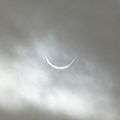 Chester-le-Street, United Kingdom, 9:36 GMT
Chester-le-Street, United Kingdom, 9:36 GMT- Tórshavn, Faroe Islands, End of totality, 9:43 local time (GMT)
 Wrocław, Poland, 10:44 local time (9:44 UTC)
Wrocław, Poland, 10:44 local time (9:44 UTC)- Hjartdal, Norway, 10:47 local time (9:47 UTC)
 Prague, Czech Republic, 10:49 local time (9:49 UTC)
Prague, Czech Republic, 10:49 local time (9:49 UTC) Kłodzko, Poland, 10:54 local time (9:54 UTC)
Kłodzko, Poland, 10:54 local time (9:54 UTC) Warsaw, Poland, 10:56 local time (9:56 UTC)
Warsaw, Poland, 10:56 local time (9:56 UTC) Budapest, Hungary, 11:00 local time (10:00 UTC)
Budapest, Hungary, 11:00 local time (10:00 UTC) Bregenz, Austria, 11:06 local time (10:06 UTC)
Bregenz, Austria, 11:06 local time (10:06 UTC)- Milan, Italy, 11:08 (10:08 UTC) – unconfirmed source
 Petrozavodsk, Russia, 13:25 local time (10:25 UTC)
Petrozavodsk, Russia, 13:25 local time (10:25 UTC)- Kiev, Ukraine, 12:28 local time (10:28 UTC)
- Ulcinj, Montenegro, 11:34 local time (10:34 UTC)
%2C_13-35_(Local).jpg) Moscow, Russia, 13:35 local time (10:35 UTC)
Moscow, Russia, 13:35 local time (10:35 UTC)
Simulation
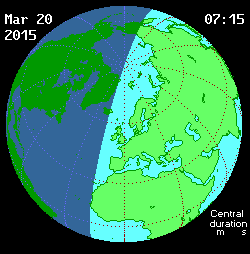 |
 |
Related eclipses
Eclipses of 2015
Solar eclipses descending node 2015-2018
Lunar eclipses
A total lunar eclipse followed on April 4, 2015, visible over Australia, and the Pacific coast of Asia and North America.[22]
Solar eclipses 2015–2018
This eclipse is a member of a semester series. An eclipse in a semester series of solar eclipses repeats approximately every 177 days and 4 hours (a semester) at alternating nodes of the Moon's orbit.[23]
| Solar eclipse series sets from 2015–2018 | ||||||
|---|---|---|---|---|---|---|
| Descending node | Ascending node | |||||
| Saros | Map | Gamma | Saros | Map | Gamma | |
120._(32844461616).jpg) Longyearbyen, Svalbard | 2015 March 20 Total |
0.9453 | 125 | 2015 September 13 Partial |
-1.1004 | |
| 130 Balikpapan, Indonesia | 2016 March 9 Total |
0.2609 | 135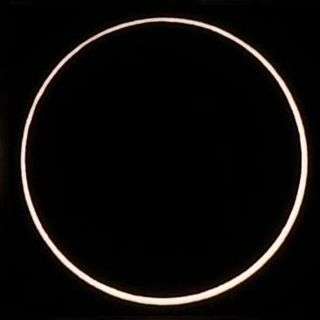 L'Étang-Salé, Réunion | 2016 September 1 Annular |
-0.3330 | |
140 Partial from Buenos Aires | 2017 February 26 Annular |
-0.4578 | 145.jpg) Casper, Wyoming | 2017 August 21 Total |
0.4367 | |
150.jpg) Partial from Olivos, Buenos Aires | 2018 February 15 Partial |
-1.2117 | 155.jpg) Partial from Huittinen, Finland | 2018 August 11 Partial |
1.1476 | |
| Partial solar eclipses on July 13, 2018, and January 6, 2019, occur during the next semester series. | ||||||
Saros series
This eclipse is a part of Saros cycle 120, repeating every 18 years, 11 days, containing 71 events. The series started with partial solar eclipse on May 27, 933 AD, and reached an annular eclipse on August 11, 1059. It was a hybrid event for 3 dates: May 8, 1510, through May 29, 1546, and total eclipses from June 8, 1564, through March 30, 2033. The series ends at member 71 as a partial eclipse on July 7, 2195. The longest duration of totality was 2 minutes, 50 seconds on March 9, 1997. All eclipses in this series occurs at the Moon’s descending node.
| Series members 55–65 occur between 1901 and 2100 | ||
|---|---|---|
| 55 | 56 | 57 |
 January 14, 1907 |
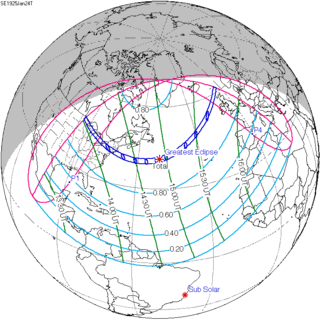 January 24, 1925 |
 February 4, 1943 |
| 58 | 59 | 60 |
 February 15, 1961 |
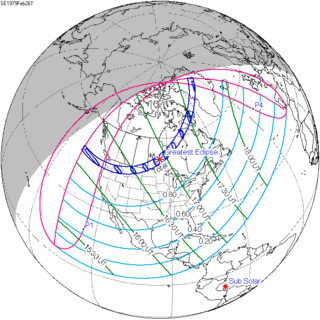 February 26, 1979 |
 March 9, 1997 |
| 61 | 62 | 63 |
 March 20, 2015 |
 March 30, 2033 |
 April 11, 2051 |
| 64 | 65 | |
 April 21, 2069 |
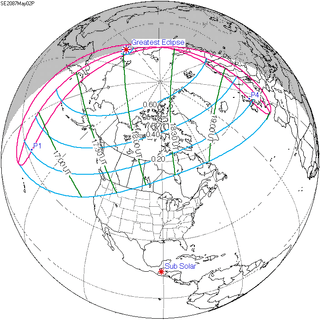 May 2, 2087 | |
Metonic series
The metonic series repeats eclipses every 19 years (6939.69 days), lasting about 5 cycles. Eclipses occur in nearly the same calendar date. In addition, the octon subseries repeats 1/5 of that or every 3.8 years (1387.94 days). All eclipses in this table occur at the Moon's descending node.
| 21 eclipse events between June 1, 2011 and June 1, 2087 | ||||
|---|---|---|---|---|
| May 31 – June 1 | March 19–20 | January 5–6 | October 24–25 | August 12–13 |
| 118 | 120 | 122 | 124 | 126 |
 June 1, 2011 |
 March 20, 2015 |
 January 6, 2019 |
 October 25, 2022 |
 August 12, 2026 |
| 128 | 130 | 132 | 134 | 136 |
 June 1, 2030 |
 March 20, 2034 |
 January 5, 2038 |
 October 25, 2041 |
 August 12, 2045 |
| 138 | 140 | 142 | 144 | 146 |
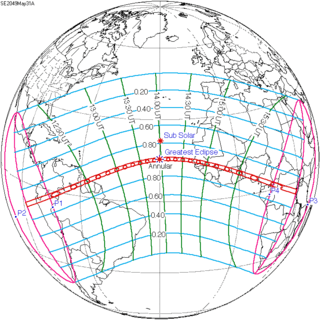 May 31, 2049 |
 March 20, 2053 |
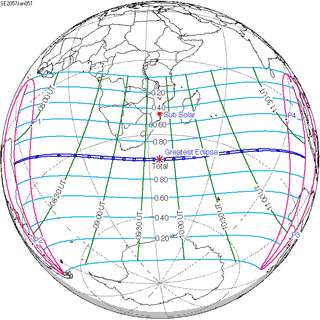 January 5, 2057 |
 October 24, 2060 |
 August 12, 2064 |
| 148 | 150 | 152 | 154 | 156 |
 May 31, 2068 |
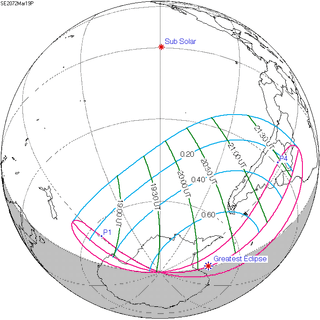 March 19, 2072 |
 January 6, 2076 |
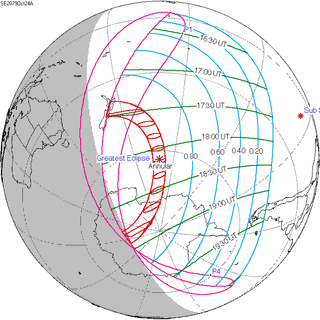 October 24, 2079 |
 August 13, 2083 |
| 158 | 160 | 162 | 164 | 166 |
 June 1, 2087 |
 October 24, 2098 |
|||
References
- F. Espenak & Xavier Jubier. "NASA - Total Solar Eclipse of 2026 August 12". Retrieved 20 March 2015.
- "Solar eclipse 2015 live: Britain to plunge into morning twilight as Moon blocks out Sun". Daily Telegraph. 20 March 2015. Retrieved 20 March 2015.
- "Solar Eclipse: live updates". Guardian. 20 March 2015. Retrieved 20 March 2015.
- Rao, Joe (20 March 2015). "Flight to Totality: How I Chased the Total Solar Eclipse of 2015 on a Jet". space.com. Retrieved 21 August 2017.
- "Solar eclipse as seen by a radio telescope". 20 March 2015. Retrieved 20 March 2015.
- "EUMETSAT case study". 20 March 2015. Retrieved 24 March 2015.
- "Meteosat-10 video of the eclipse". 20 March 2015. Retrieved 24 March 2015.
- Eckert, Vera. "European power grids keep lights on through solar eclipse". reuters.com.
- Solar Eclipse March 2015 Policy Brief European Network of Transmission System Operators for Electricity, 15 July 2015
- "Solar Eclipse 2015 – Impact Analysis" pp3+6+7+13 . European Network of Transmission System Operators for Electricity, 19 February 2015. Accessed: 4 March 2015.
- "Curve of potential power loss". ing.dk.
- S. L. Gray, R. G. Harrison. "Diagnosing eclipse-induced wind changes" Proceedings of the Royal Society. DOI: 10.1098/rspa.2012.0007 Published 25 May 2012. Archive
- "In 2015, first of six supermoons comes on January 20". Retrieved 20 March 2015.
- Weisz, Tuly (12 March 2015). "Passover Blood Moon Preceded by Exceedingly Rare Solar Eclipse". breakingisraelnews.com.
- "Solar eclipse Friday has some looking for signs from God". timesofisrael.com.
- Weisz, Tuly (22 March 2015). "Blood Moon Enthusiasts Show Total Enthusiasm for Jerusalem's Partial Eclipse". breakingisraelnews.com.
- 'Breathtaking' solar eclipse witnessed by millions BBC
- "Solar eclipse 2015: Brief glimpses as clouds hide spectacle". irishtimes.com.
- "Thick cloud hides solar eclipse in France". thelocal.fr. 20 March 2015.
- "Partial solar eclipse over Germany". www.mpg.de.
- "Solar eclipse over Poland". thenews.pl.
- 2015 Apr 04 chart: Eclipse Predictions by Fred Espenak, NASA/GSFC
- van Gent, R.H. "Solar- and Lunar-Eclipse Predictions from Antiquity to the Present". A Catalogue of Eclipse Cycles. Utrecht University. Retrieved 6 October 2018.
Bibliography
External links
| Wikimedia Commons has media related to Solar eclipse of 2015 March 20. |
- Northern Equinox Eclipse, APOD 3/21/2015, totality of Longyearbyen, Svalbald
- A Double Eclipse of the Sun, International Space Station moving in front of the eclipsed sun, APOD 3/22/2015, partial eclipse of Fregenal de la Sierra, Spain
- Diamond Rings and Baily's Beads, APOD 3/28/2015, totality of Longyearbyen, Svalbald
- Corona from Svalbard, APOD 3/31/2015
- Centered and aligned video recording of full phase of total solar eclipse on YouTube
- Eclipse spectacle AstroBob, 3/20/15
- A Full time-lapse taken by UK resident Roger Skillin in Iceland where it was 97.3% totality on YouTube
